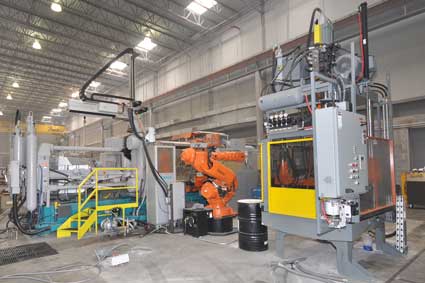Die Cast Machinery Purchasing / Buying
 Die Cast Machinery, LLC is the world wide leader in the market of pre-owned and reconditioned die cast equipment.
Die Cast Machinery, LLC is the world wide leader in the market of pre-owned and reconditioned die cast equipment.
We handle an extensive amount of die cast equipment including: hot chamber machines, cold chamber machines, trim presses, die cast automation, inspection equipment, melting and holding furnaces. We also have the resources to customize die cast machinery to fit your needs.
We have many customers looking for used die casting equipment. Because of this demand we are constantly looking to buy good used die casting machines. If you are interested in us purchasing your equipment don't hesitate to contact us.
We also handle die cast facility liquidations. Please call us to set up a confidential, no obligation meeting to talk with someone about the options available when considering closing a die cast facility.
Our goal is always the same, to recover as much capital as possible for you, while minimizing expenses.
Die Cast Machines
The two major processes in the die cast industry are hot chamber and cold chamber machines. Hot chamber machines are typically used for metals with low melting temperatures such as lead, magnesium, zinc and zinc alloys like zamak. The molten metal is contained within the hot chamber machine along. Mechanisms within the hot chamber machine are in contact with the molten metal and if hot enough, could damage the die cast machine. Therefore, metals with high melting temperatures are not typically cast with hot chamber machines.
Cold chamber machines are able handle metals with much higher melting temperatures as the mechanisms in the cold chamber machine are not in contact with the molten metal. One popular high temperature die casting process is aluminum die casting. The metal to be cast is transported to the cold chamber machine in from an outside source. The tradeoff however is lower production rates. Hot chamber process has higher production rates since the molten metal does not have to be transported from outside the machine. In addition, low melting temperature metals used in the hot chamber process have reduced chill time.
Variations in these die casting processes include 4 slide casting (miniature), squeeze cast and semi-solid mold (SSM).
Aluminum Holding and Melting Furnaces
Prior to casting the metal, the metal must be melted in a high temperature furnace called a melting furnace. Metal alloys are melted in the furance to be cast. Scrap metals from downstream trimming and finishing process are also used to charge the furnace. Melting furnaces operate at temperatures between 600 degrees farenheit to over 1200 degrees farenheit. Melting and holding furnaces can account over half the energy used in die cast manufacturing.
Gas vs. Electric
An important consideration when selecting melting and holding furnaces is choosing gas fired or electric. Gas fired furnaces offer fast melting capability, large capacities and a reliable fuel source as it is not prone to electrical outages. Typically a gas fired furnace will have a lower inital cost as compared to an electrically powered furnace.
There has been a trend in recent years for electric furnaces due to the price of fuel. Electric furnaces hace benefits of their own such as a lower melt loss, less metal contamination and a better control of the heat. A recent study showed metals melted in electric furnace possessed higher tensile and yield strength, improving the overall quality of the product. If the energy efficiency and melt quality are the main objective, electric furnaces are the best option. Electric furnaces are also quieter and more environmentally friendly, producing zero flue emissions from on-site energy source.
There are several types of furnaces that are used for melting and holding in the die casting industry. These include: immersion, dosing, reverberatory, crucible , induction, and stack furnaces. Major manufacturers include: Thermtronix® Corporation, The Schaefer Group, Inc., Lindberg/MPH, MELTEC (Frech), New Century Heaters Ltd. and Modern Equipment Company, Inc.
Trim Presses
Flash is created when pressurized molten metal squeezes our around the perimeter of the mold during the casting process. The “flash” is extremely thin and sharp and needs to be removed. Integral parts of the cast that are required to manufacture the part like runners, gates, overflows, vents are no longer required and also need to be removed. A trim press can shears or cut off the undesired features, which can then be recycled.
Trim tools called a trim die can be used to sheer flash and unwanted elements that results from the die cast process. Trim presses apply several tons of pneumatic or hydraulic pressure to force two halves of the trim die together, shearing off unwanted metal. The trim die is installed into a trim press and enables the automation of trimming process synchronized with extraction. Die casting trim dies streamlines production and speeds up the production process.
Spectrographs and Industrial X-Ray Machines
Spectrometers and X-ray machines can help you locate defects that naturally occur in the die cast process. Defects can be caused by imperfections in the alloys, stress and fatigue, contamination. Common types of defects that can occur in die casting include porosity, tearing, air locks, cavities, and inclusions. Both methods of non-destructive testing (ND) can be used to locate problems in the part and improve the quality of production. Since NDT testing is non destructive, it is very cost effective.
Regardless of what types of equipment you may have to sell, consider Die Cast Machinery. We specialize in buying used die cast machines of all types.

